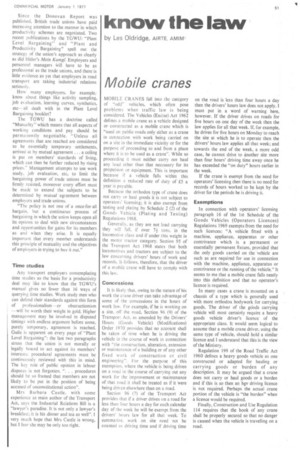know the law
Page 53

If you've noticed an error in this article please click here to report it so we can fix it.
by Les Oldridge, AIRTE, AMIM1
Mobile cranes
MOBILE CRANES fall into the category of "odd" vehicles, which often pose problems when traffic law is being considered. The Vehicles (Excise) Act 1962 defines a mobile crane as a vehicle designed or constructed as a mobile crane which is "used on public roads only either as a crane in connection with work being carried on on a site in the immediate vicinity or for the purpose of proceeding to and from a place where it is to be used as a crane". While so proceeding it must neither carry nor haul any load other than that necessary for its propulsion or equipment. This is important because if a vehicle falls within this definition a reduced rate of duty of £5 a year is payable.
Because the orthodox type of crane does not carry or haul goods it is not subject to operators' licensing; it is also exempt from testing and plating by Schedule 2 (2) of the Goods Vehicle (Plating and Testing) Regulations 1968.
Generally, as they are not load carrying they will fall, if over 7+ tons, in the locomotive class and if under this weight in the motor tractor category. Section 95 of the Transport Act 1968 states that both locomotives and tractors are subject to the law concerning drivers' hours of work and records. It follows, therefore, that the driver of a mobile crane will have to comply with this law.
Concessions It is likely that, owing to the nature of his work the crane driver can take advantage of some of the concessions in the hours of work law. For example, if he is working on a site, off the road, Section 96 (9) of the Transport Act, as amended by the Drivers' Hours (Goods Vehicle) (Modifications) Order 1970 provides that no account shall be taken of time when he is driving the vehicle in the course of work in connection with "the construction, alteration, extension or maintenance of a building or of any other fixed work of construction or civil engineering". For the purpose of this exemption, where the vehicle is being driven on a road in the course of carrying out any work for the improvement or maintenance of that road it shall be treated as if it 'were being driven elsewhere than on a road.
Section 96 (7) of the Transport Act provides that if a driver drives on a road for less than four hours a day for each calendar day of the week he will be exempt from the drivers' hours law for all that week. To summarize, work on site need not be counted as driving time and if driving time on the road is less than four hours a day then the drivers' hours law does not apply. I must put in a word of warning here, however. If the driver drives on roads for five hours on one day of the week then the law applies for all that week. If, for example, he drives for five hours on Monday to reach the site at which he is to operate then the drivers' hours law applies all that week; and towards the end of the week, a more odd case, he cannot drive to another site more than four hours' driving time away once he has exceeded the "on duty" hours earlier in the week.
If the crane is exempt from the need for operators' licensing then there is no need for records of hours worked to be kept by the driver for the periods he is driving it.
Exemptions
In connection with operators' licensing paragraph 16 of the 1st Schedule of the Goods Vehicles (Operators Licences) Regulations 1969 exempts from the need for such licences: "A vehicle fitted with a machine, appliance, apparatus or other contrivance which is a permanent or essentially permanent fixture, provided that the only goods carried on the 'vehicle are such as are required for use in connection with the machine, appliance, apparatus or contrivance or the running of the vehicle." It seems to me that a mobile crane falls neatly into this definition and that no operator's licence is required.
In many cases a crane is mounted on a chassis of a type which is generally used with more orthodox bodywork for carrying goods. The driver of the gdods carrying vehicle will most certainly require a heavy goods vehicle driver's licence of the appropriate class. It would seem logical to assume that a mobile crane driver, using the same type of vehicle, should hold a similar licence and I understand that this is the view of the Ministry.
Regulation 199 of the Road Traffic Act 1960 defines a heavy goods vehicle as one constructed or adapted for hauling or carrying goods or burden of any description. It may be argued that a crane does not carry or haul goods or a burden and if this is so then an hgv driving licence is not required. Perhaps the actual crane portion of the vehicle is "the burden" when a licence would be required.
Finally, Construction and Use Regulation 114 requires that the hook of any crane shall be properly secured so that no danger is caused when the vehicle is travelling on a road.




















































































